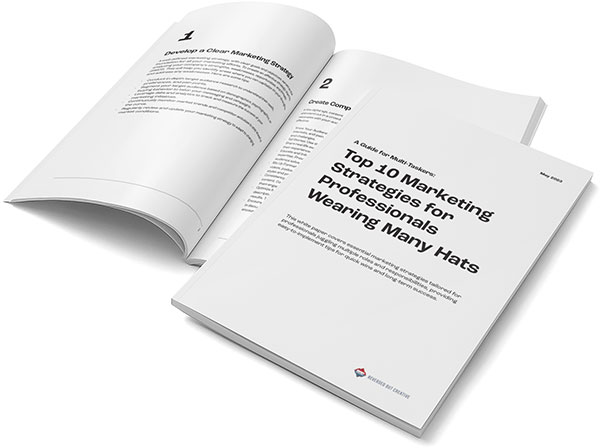
Why is bounce rate important? Know everything about it!
There are many people who have no idea about what bounce rate is. With many misleading conceptions about this term, we have decided to share in detail what bounce rate is and why it is important. We will also discuss what can be done with the information that you will receive through bounce rate.
This article is for SEO professionals, UX designers, marketing analysts, or anyone who has a website. If you fall under any of these categories, this is the article for you and will definitely be beneficial.
What does bounce rate mean? Understanding the term!
Many people confuse bounce rates with exit rates. But bounce rate is the percentage of visitors who visit your website but leave without staying and interacting there for long. Bounce rate is a specific indicator of page effectiveness and success. In short, the higher bounce rate means that your website is not performing well in terms of engagement. This is a clear signal that you need to improve your landing page. This is one of the most common metrics of Google analytics that is used while analyzing website traffic.
In simple words, bounce rate is the percentage of website visitors who navigate away from the website after viewing one page only and not engaging more with the site. Note that the visitor can enter the website from any source.
Meaning of high and low bounce rate? Understanding the term!
Having a high bounce rate is known to be bad for a website whereas the lower number indicates good website health. In reality, this is not the case.
To understand further, let’s shed some light on different questions that will determine the bounce rate –
i) What is the motive of the page?
ii) What is the benchmark of the bounce rate?
iii) What is the relation between bounce rate, revenue & conversion metrics?
iv) What is the traffic quality a website is receiving?
Let’s discuss each of these points in detail one by one –
Understanding the motive or purpose of the page is the most important thing in this list. Let’s look at a situation to understand it better – if you are sending the paid traffic from Google to the landing page and the bounce rate of that URL is high, it is a serious problem. You should reconsider checking and optimizing the page. In fact, for transactional landing pages, the bounce rate can help determine conversion opportunities.
ii) What is the benchmark of the bounce rate?
As per Google Analytics, bounce rate is triggered by several different events after visiting the landing page –
- Returning to the google search result pages
- Quitting the browser
- Moving to the new URL
- Redirecting to the outbound link on the page
- Session Timeout
- Triggering an event and leaving the page
Coming to the bounce rate benchmarks, you need to know that it is usually calculated based upon website type, industry, device, and channel.
Bounce Rate Benchmark by Website Type
In general, there are two types of websites – Blogs and Reference pages.
i) Blogs / Content-based website
Blogs are usually known to have a higher bounce rate as it is giving information on different topics; people come to the blog, absorb the content, and leave. With engagement, when it comes to blogs, people often engage by commenting on them. All things considered, the benchmark for content-oriented sites is usually high.
ii) Reference pages
Another type of landing page that we often come across is the reference page. These are pages that have many options for visitors to engage with. The bounce rate for these kinds of informational pages is usually lower than content-based websites.
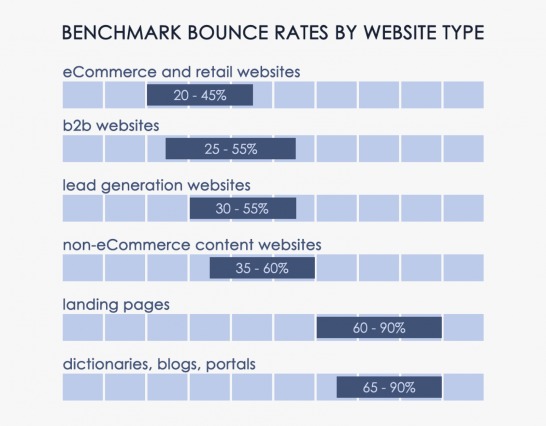
Bounce Rate Benchmark By Industry
The bounce rate benchmark varies for every industry. Below is the chart for the bounce rate benchmark for every industry.
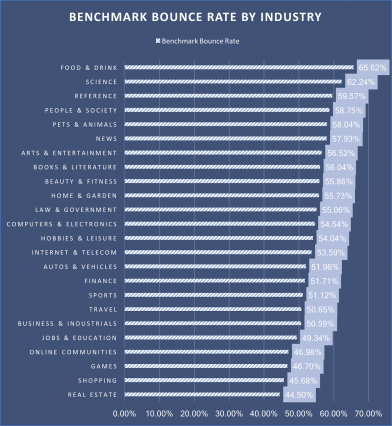
Benchmark by Channel
The Google analytics channel defines the origin of the traffic. Here are a few channels that you need to know about –
- Direct
- Organic Search
- Paid Search
- Display
- Referral
- Social
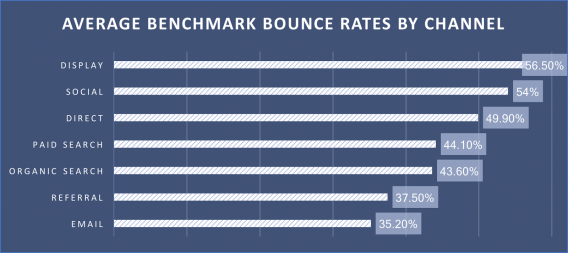
Bounce Rate Benchmark by Device
Here is a chart that demonstrates the bounce rate benchmark per device – mobile, tablet, and desktop.
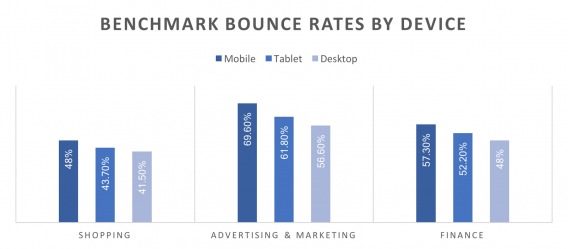
Conclusion
In the end, we hope that now you know what bounce rate is and why it is important for the accurate analysis of your website. There are many things that you need to keep in mind when it comes to analyzing bounce rates. In the above article, you would get information about the benchmark of bounce rate on the basis of different factors.
Contact Us
At Reversed Out Creative, we understand the challenges and opportunities presented by AI disruption. Our team of experts specializes in web design, SEO, graphic design, and digital marketing services. Reach out to us through our contact form to learn more about navigating the evolving job market and embracing the potential of AI. Together, let’s shape a future that combines human ingenuity with the power of AI.
Next Article: A Complete Guide For Uber Eats Clone app!
©2025 Reversed Out LLC. All rights reserved. Privacy Policy.


